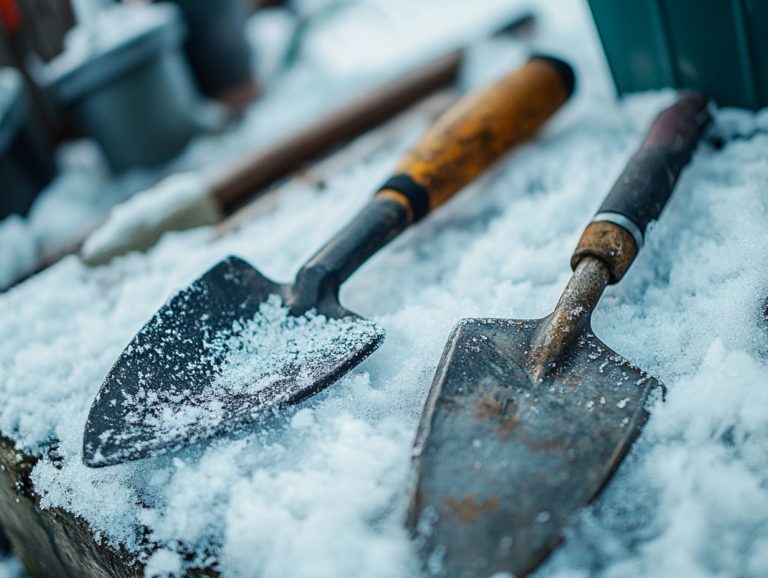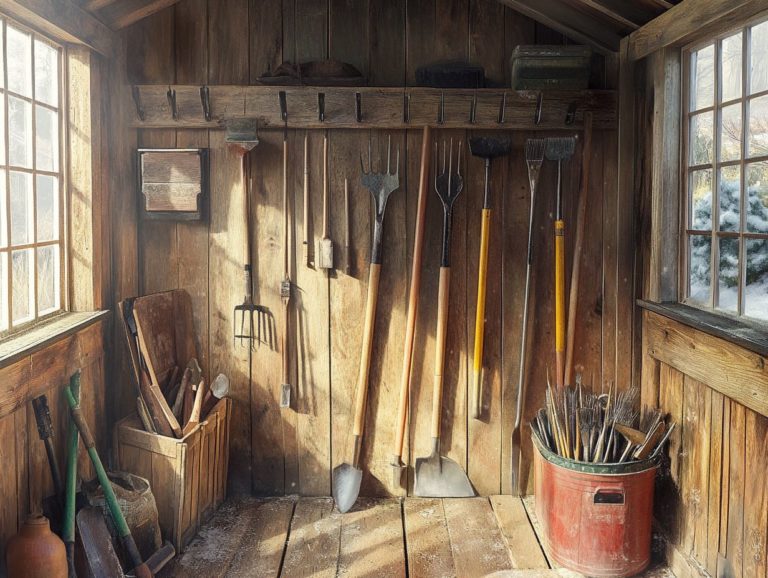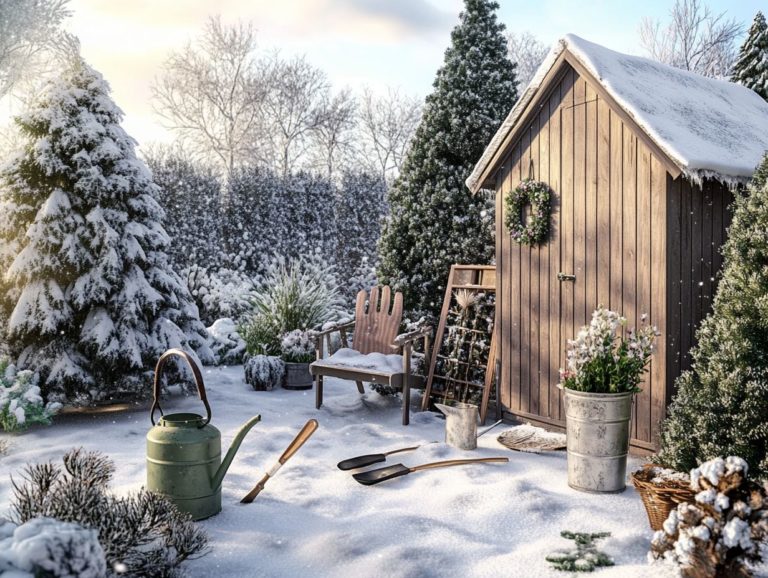Best Tools for Cold-Weather Herb Gardens
Gardening enthusiasts often envision spring and summer as the ultimate seasons for cultivating herbs. However, embracing cold-weather herb gardening opens up a world of unique opportunities and rewards.
This guide provides essential insights, from selecting the right herbs to preparing your garden for frosty conditions. You will discover how protective coverings, greenhouses, and innovative heating techniques can extend your growing season and keep your herbs thriving.
Additionally, you will find valuable tips on watering, pest control, and harvesting. These ensure your herb garden flourishes even in the chill of winter. Whether you re a seasoned gardener or just beginning your journey, there’s something here for everyone eager to appreciate the beauty of cold-weather gardening.
Contents
- Key Takeaways:
- 1. Choosing the Right Herbs for Cold Weather
- 2. Preparing the Garden for Cold Weather
- 3. Protective Coverings for Cold Weather
- 4. Using a Greenhouse for Cold-Weather Herb Gardening
- 5. Heat Sources for Cold-Weather Herb Gardens
- 6. Insulation Techniques for Cold-Weather Herb Gardens
- 7. Watering and Moisture Control in Cold Weather
- 8. Pest Control for Cold-Weather Herb Gardens
- 9. Harvesting Herbs in Cold Weather
- 10. Storing Herbs for Winter Use
- 11. Benefits of Cold-Weather Herb Gardening
- 12. Challenges of Cold-Weather Herb Gardening
- 13. Tips for Successful Cold-Weather Herb Gardening
- 14. Recommended Tools for Cold-Weather Herb Gardens
- 15. Final Thoughts on Cold-Weather Herb Gardening
- Frequently Asked Questions
- 1. What are the best tools for maintaining a cold-weather herb garden?
- 2. Can I use regular gardening tools for my cold-weather herb garden?
- 3. Are there any tools specifically designed for cold-weather herb gardens?
- 4. What are the benefits of using specialized tools for cold-weather herb gardens, including winterizing garden techniques?
- 5. How often should I clean and maintain my cold-weather herb garden tools?
- 6. Where can I purchase the best outdoor furniture and tools for my cold-weather herb garden?
Key Takeaways:
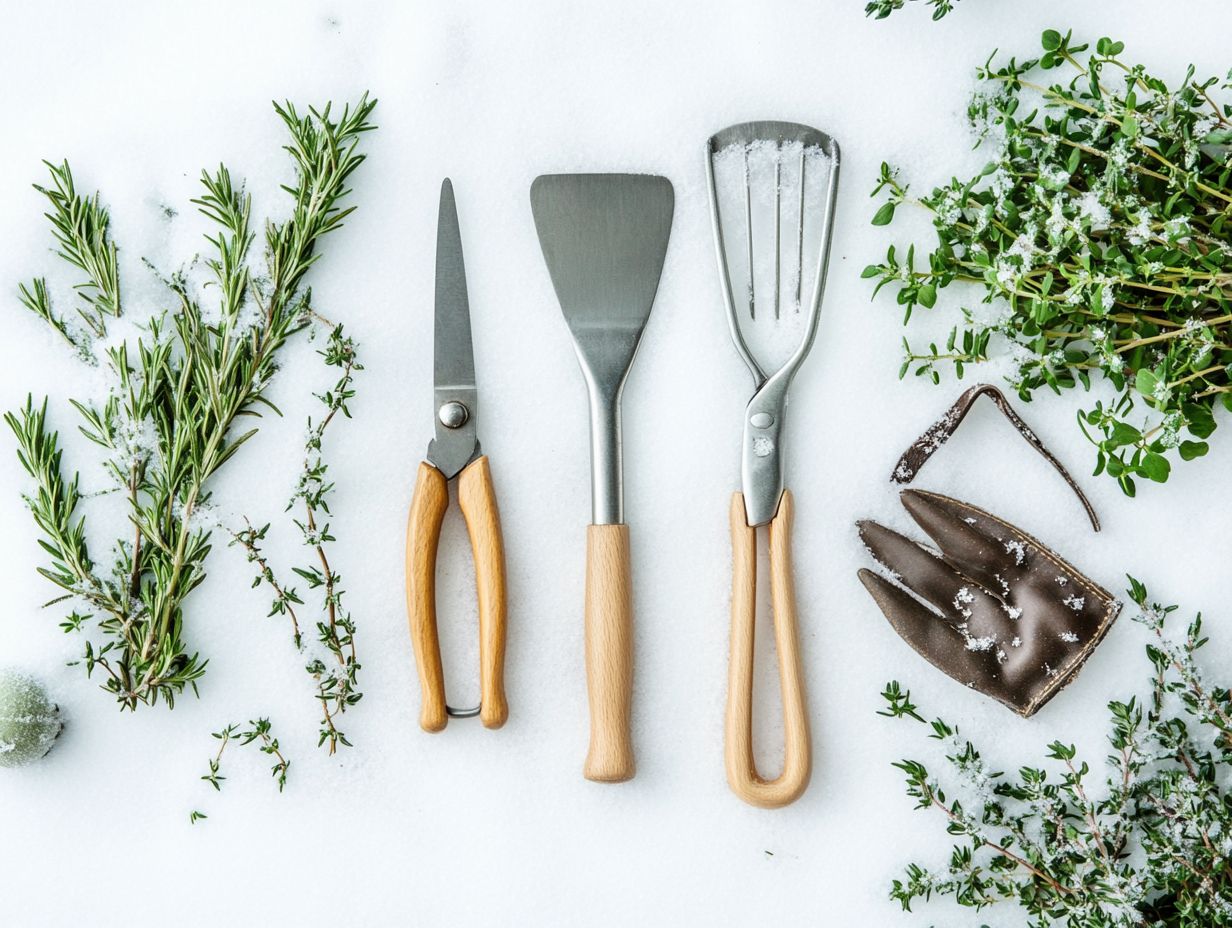
- Choose cold-hardy herbs such as rosemary and thyme for successful winter gardening.
- Prepare your herb garden for cold weather by adding mulch and protecting delicate plants.
- Invest in protective coverings like cloches or row covers to shield herbs from harsh weather conditions.
1. Choosing the Right Herbs for Cold Weather
Choosing the right herbs for cold weather is essential if you want to keep your herb garden thriving during the winter months. Cold-resistant plants like basil, parsley, cilantro, oregano, and thyme can not only survive but also thrive in cooler conditions, offering fresh flavors all season long.
With the proper selection and care, your indoor gardening can transform your winter experience and yield delicious results, even in places like Iowa, where temperatures can drop significantly.
Know your herbs! Each one has unique traits that can make or break your winter garden. For example, thyme and oregano are remarkably hardy, often requiring minimal care and thriving in temperatures as low as 20 F. Parsley and cilantro prefer a slightly warmer climate, but they can still hold their own if covered and protected during particularly frigid spells.
Experts like Nadia Hassani recommend using pots with excellent drainage since too much water can lead to a condition where plants decay in the colder months. Wallaces Garden Center also suggests placing mulch around the base of your plants for additional insulation. By adapting your gardening methods based on these professionals’ insights, you can ensure that your indoor garden flourishes, opening up a world of vibrant flavors and culinary delights all winter long.
2. Preparing the Garden for Cold Weather
Preparing your garden for winter requires a thoughtful approach to ensure the longevity and health of your plants and tools. By implementing proper maintenance routines such as cleaning tools, ensuring effective drainage, and storing outdoor furniture correctly you can significantly enhance your garden’s resilience throughout the season.
-
Start by giving all your gardening tools a thorough cleaning, removing any dirt or debris that might harbor diseases. Once you’ve cleaned them, inspect for any damage and take the time to make necessary repairs or replacements.
-
Next, think about protecting your more vulnerable plants with a layer of mulch or frost cloth to shield them from the biting cold. Don t forget to secure your outdoor furniture; you can either bring it indoors or use protective covers to help prolong its life.
-
Lastly, organizing your storage area is essential. Use labeled bins or hooks for easy access to your tools and create a designated space for seasonal equipment. This will streamline your gardening activities when spring arrives, making your gardening experience more efficient and enjoyable.
Ready to brighten your winter? Share your gardening stories with us!
3. Protective Coverings for Cold Weather
Utilizing protective coverings for your plants during cold weather is essential for their survival and growth. Consider using frost-resistant pots and insulation pots. Wrapping your pots with insulating materials prevents root damage and helps regulate soil temperature. This keeps even your outdoor furniture safe from harsh winter conditions.
Materials like burlap, bubble wrap, and old blankets serve as effective choices for wrapping pots, each offering unique heat retention. Layering these materials enhances insulation and allows for necessary airflow to prevent moisture buildup.
Frost-resistant pots are designed with insulated materials, providing extra protection that traditional pots lack. Achieve a snug fit around the base and place your pots close together. This creates a microclimate that further shields them from extreme cold.
Combine these techniques to foster a healthier growing environment during winter.
4. Using a Greenhouse for Cold-Weather Herb Gardening
A greenhouse is your best ally for nurturing an herb garden during chilly months. It offers a controlled environment that fosters growth. Incorporating heat sources like heating mats cultivates optimal conditions for growing herbs year-round, ensuring you have a steady supply of fresh ingredients.
Pay attention to temperature control and humidity levels. Use thermostats and hygrometers for precise monitoring, which is vital for maintaining the ideal climate for herbs like basil and thyme, which thrive in warmer conditions.
Strategically place vents and fans to enhance air circulation. This helps prevent mold and promotes healthy growth. Understand the needs of different herbs to grow a thriving garden, even when outdoor weather isn t cooperating.
5. Heat Sources for Cold-Weather Herb Gardens
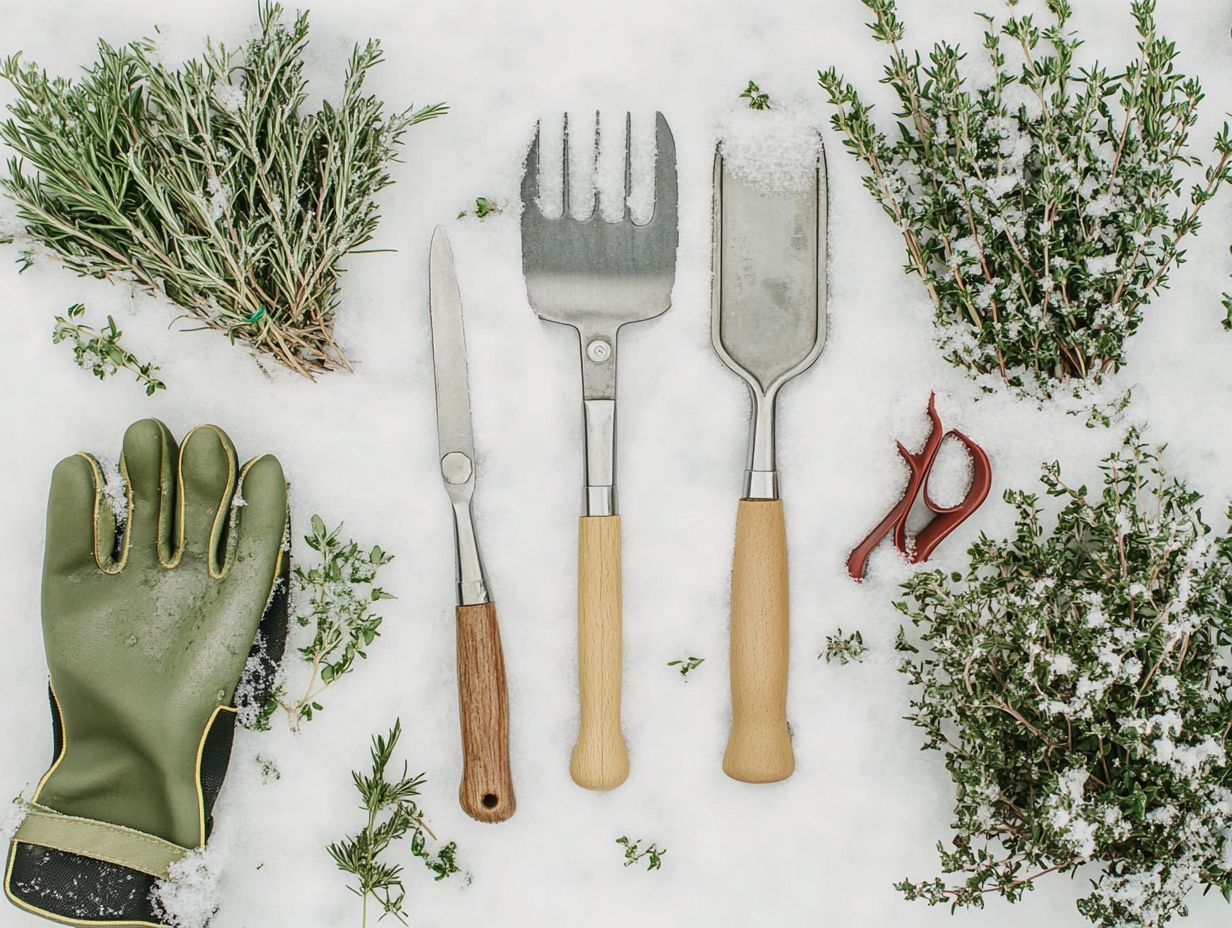
Implementing effective heat sources is crucial for your cold-weather herb garden, especially if you’re using a greenhouse. Heating mats help maintain the ideal temperature for cold-resistant plants, ensuring they thrive even in frigid conditions.
Consider radiant heaters and thermostatically controlled heating cables, which automatically adjust to maintain the right temperature. These options are essential for herbs like basil, cilantro, and parsley, which flourish in moderate temperatures. Electric soil heaters also assist in establishing seedlings during their early growth phases, stimulating faster root development.
If growing herbs in pots, place them near south-facing windows to maximize sunlight exposure and enhance the natural warmth they receive.
By understanding the specific temperature needs of various herbs, you can select the right heat sources for a more fruitful harvest.
6. Insulation Techniques for Cold-Weather Herb Gardens
Insulation techniques can seriously boost your plants’ chances of surviving the cold. Use insulation pots and wrap them carefully. Proper insulation acts as a protective barrier against frost damage, allowing you to maintain your gardening tools even amidst harsh winter conditions.
Incorporate materials like burlap, bubble wrap, or straw for an additional layer of protection around your pots. You might also consider foam or thermal blankets, which effectively stabilize temperature fluctuations.
Frost-resistant pots made from durable materials like fiberglass or high-density polyethylene are reliable choices, ensuring your plants remain shielded from extreme weather. Adopting these insulation strategies, along with using the best tools for late winter planting, minimizes damage to your leafy greens and herbs, leading to a flourishing garden during the colder months.
Start insulating your plants today for a thriving winter garden!
7. Watering and Moisture Control in Cold Weather
Watering and moisture control in cold weather require your careful attention to prevent plant stress and ensure healthy growth.
By utilizing the right watering equipment and ensuring proper drainage holes, you can maintain the ideal moisture levels in both outdoor and indoor gardening settings.
As temperatures drop, your plants enter a state of dormancy, which means they are in a resting state and greatly lowers how much water they need. Many gardeners often overlook the importance of adjusting their watering schedules to reflect this change.
During winter, humidity levels can fluctuate dramatically, influencing how quickly the soil dries out. Make sure to monitor moisture levels closely by checking the top few inches of soil with your fingers or using a moisture meter.
This practice not only helps you determine when to water but also prevents too much water, which can lead to root rot and other complications. By adopting a balanced approach, you can ensure that your plants remain vibrant and healthy, even in the chill of winter.
8. Pest Control for Cold-Weather Herb Gardens
Effective pest control strategies are crucial for you to maintain a healthy cold-weather herb garden, especially when cultivating cold-resistant plants indoors.
By implementing a combination of preventative measures and organic solutions, you can significantly reduce pest infestations and ensure your herb garden thrives throughout the winter season.
Utilizing a blend of these strategies will help you create an environment that deters unwanted pests. For example, introducing beneficial insects like ladybugs or applying neem oil can provide a natural defense without jeopardizing the health of your plants.
Regular inspections of your plants for early signs of trouble, such as discoloration or unusual growth patterns, will enable you to intervene quickly. Use sticky traps and ensure good air circulation to keep pests away, allowing you to nurture your herbs effectively, even amidst the winter chill.
9. Harvesting Herbs in Cold Weather
Harvesting herbs in cold weather can be both rewarding and challenging, requiring specific techniques to ensure you achieve optimal quality and flavor.
Cold-resistant plants still offer a fresh harvest, especially if you’re cultivating them indoors where conditions are more manageable.
Timing is key to gathering these aromatic greens. The best moment to pick them is early in the morning after a frost, just before the sun warms the leaves this is when the flavor is at its peak!
Utilizing the right tools, like sharp shears or scissors, is essential to prevent damage to the plants, allowing them to continue thriving.
Once you’ve harvested, proper storage is key. Wrapping your herbs in a damp paper towel and placing them in a sealed container in the fridge can significantly extend their freshness.
By following these straightforward practices, you can relish vibrant flavors even amidst the winter chill!
10. Storing Herbs for Winter Use
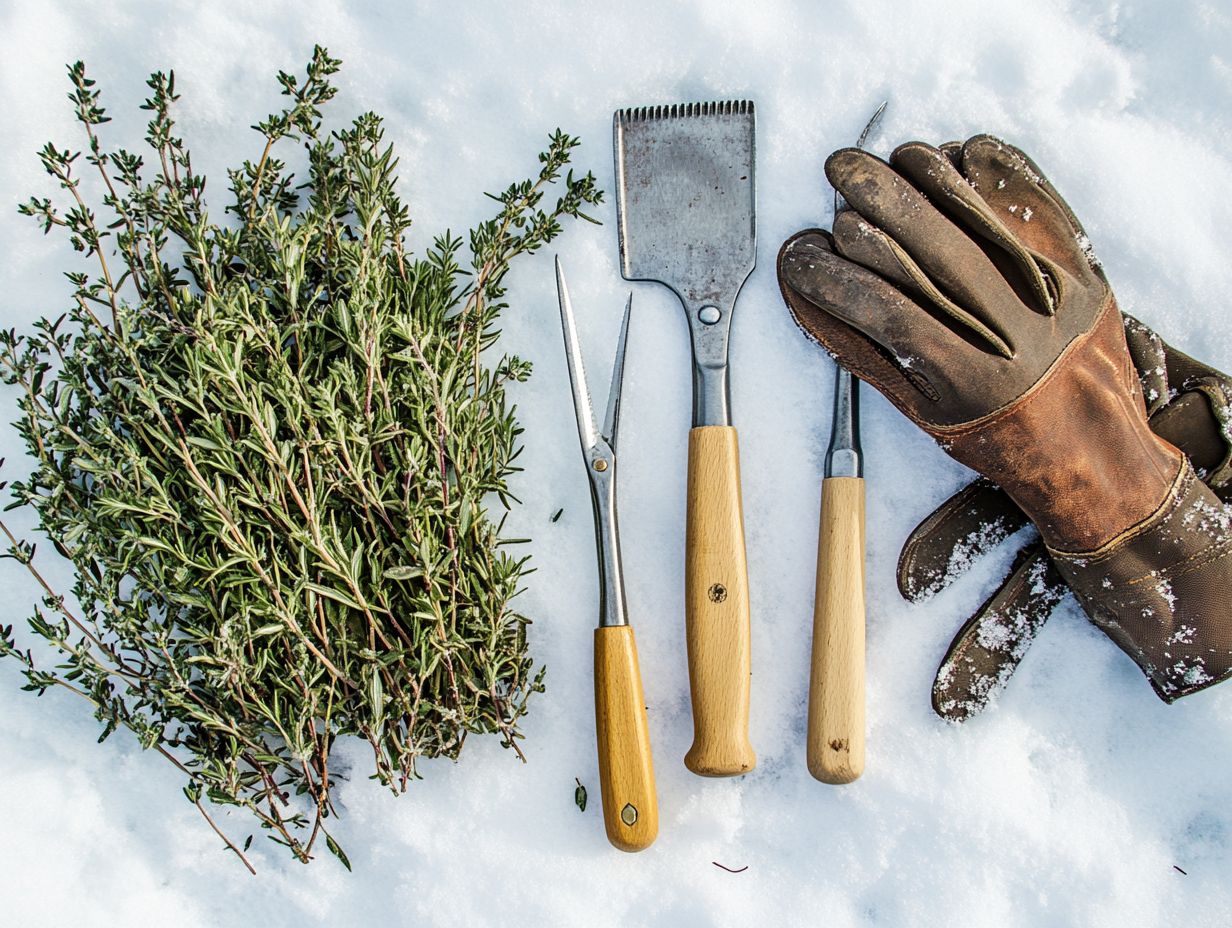
Storing herbs for winter use is essential for preserving the vibrant flavors and benefits of your garden’s bounty.
By implementing proper storage techniques, you can ensure that your organic seeds and harvested herbs remain viable and flavorful throughout the colder months.
Exploring various storage methods can make a significant difference in maintaining the freshness of these aromatic plants.
Drying herbs is a popular choice, as it not only concentrates their flavors but also extends their shelf life, making them easy to rehydrate and incorporate into your dishes.
Alternatively, freezing allows you to capture their essence, providing quick access to those vibrant flavors in soups and sauces.
It’s also crucial to use airtight containers, as they protect herbs from moisture and light, both of which can lead to degradation.
Proper storage conditions not only safeguard freshness but also preserve the distinctive qualities that you, as a home cook or chef, cherish.
11. Benefits of Cold-Weather Herb Gardening
Cold-weather herb gardening offers a wealth of benefits. Enjoy fresh herbs all year, even in winter. This practice elevates your culinary adventures and champions sustainable gardening methods, especially when utilizing organic seeds and mastering indoor gardening techniques for optimal growth.
By weaving fresh herbs into your daily meals, you unlock a treasure trove of health advantages, including improved digestion, enhanced immunity, and a boost in antioxidants. Cultivating herbs at home can lead to significant savings by sparing you from the expense of overpriced pre-packaged varieties from the store.
Indoor gardening grants you the fantastic ability to extend your growing season, enabling you to nurture a diverse array of herbs no matter what the weather outside may be.
This approach enables you to take control of your food sources, fostering a more sustainable lifestyle by reducing your dependence on store-bought products.
12. Challenges of Cold-Weather Herb Gardening
Cold-weather herb gardening is not just rewarding; it’s a thrilling adventure! However, it also brings its own set of unique challenges that demand careful planning and management. From the constant threat of frost damage to the upkeep of your tools and equipment, having access to the ultimate guide to cold weather gardening tools is essential for successfully navigating the colder months.
You may wrestle with temperature fluctuations that can affect plant growth and yield. Be proactive to protect your sensitive herbs. Using protective covers for plants or sheets that shelter plants from cold can help retain warmth and keep those delicate plants cozy.
Pest management will also be on your radar. While some pests may meet their end in colder temperatures, others might thrive during milder winter spells. Implement organic pest control methods, like introducing beneficial insects or using natural repellents, to tackle these issues head-on.
Maintaining soil health becomes crucial, as the cold can deplete vital nutrients. Regularly amend your soil with organic compost and ensure proper drainage to protect against waterlogged conditions while enhancing nutrient availability for robust plant growth.
13. Tips for Successful Cold-Weather Herb Gardening
Implementing the right strategies for successful cold-weather herb gardening can significantly enhance your garden’s productivity and health throughout winter. By establishing proper maintenance routines, carefully choosing your watering tools, and employing effective pest control methods, you can create a thriving herb garden. Additionally, utilizing the top 10 must-have tools for winter gardening will ensure your success, even in the coldest months.
Planting at the right time boosts your success. Ideally, late summer or early fall presents the perfect window for sowing cold-resistant varieties, such as hardy rosemary or sage, which can withstand lower temperatures.
Approach watering with intention; a deep watering session during warmer afternoons will help the soil retain moisture, while misting your herbs can prevent frost damage. Using mulch can also insulate the soil, keeping roots warm and cozy.
Selecting plants that naturally flourish in winter conditions leads to a vibrant garden that remains productive, even during the harshest cold spells.
14. Recommended Tools for Cold-Weather Herb Gardens
The right tools are essential for efficient gardening and keeping your plants healthy in winter. Invest in specialized cleaning tools to maintain your gear, along with proper storage solutions that keep everything organized and in peak condition.
A good pair of insulated gloves will be your best friends, shielding your hands from the cold while allowing you to plant and prune comfortably and effectively. Don’t underestimate the value of a high-quality soil thermometer; it’s key for accurately gauging soil temperature and ensuring you plant your herbs at just the right time. Additionally, consider learning how to make your own cold-weather gardening tools to enhance your gardening experience.
If you re facing snow or ice, a sturdy snow shovel or ice scraper is critical for quick access to your garden beds. Cleaning tools like brushes and scrapers will help maintain your equipment on a budget, preventing rust and build-up over time.
Remember, regular maintenance of these tools, including thorough cleaning after each use, will extend their life and keep them effective throughout the entire gardening season.
15. Final Thoughts on Cold-Weather Herb Gardening
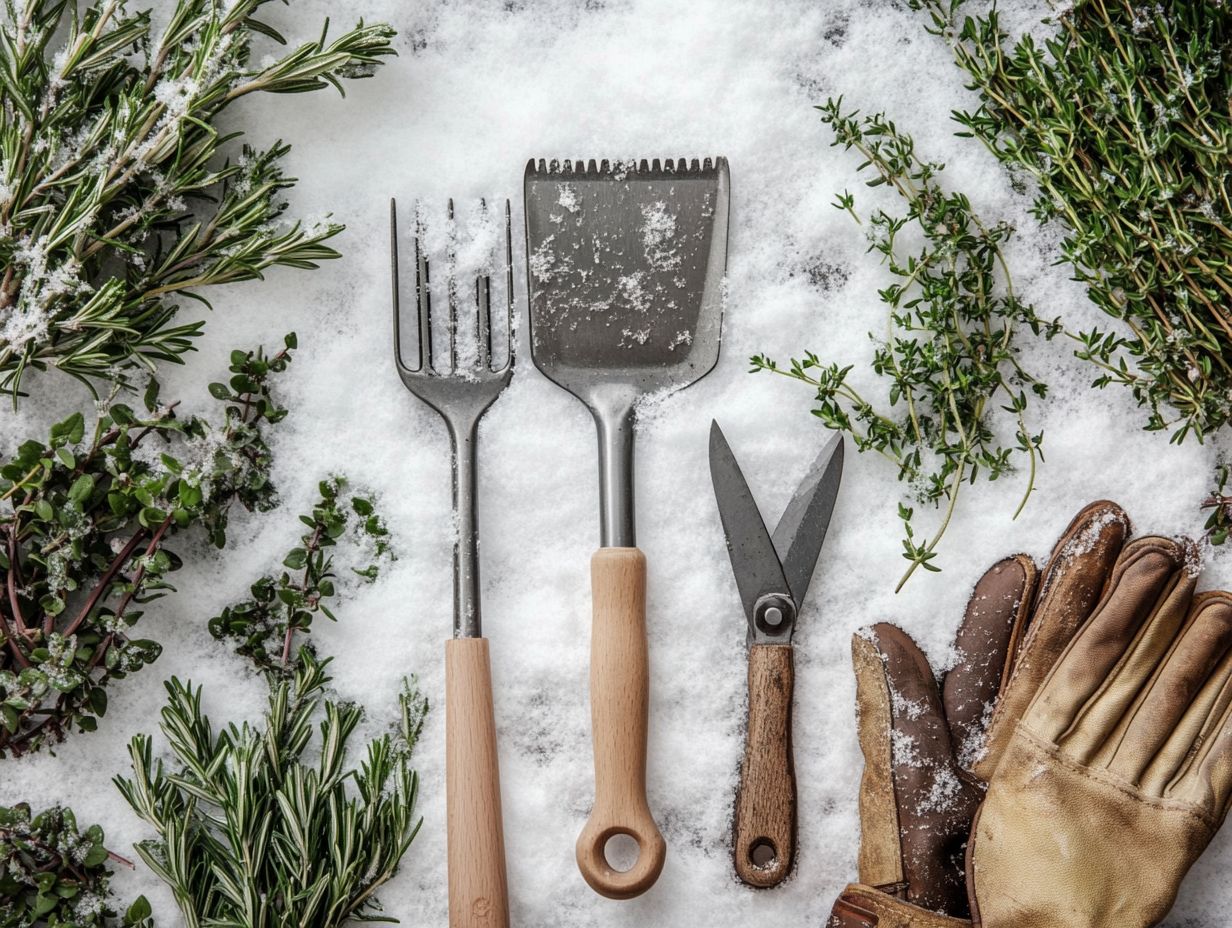
Cold-weather herb gardening offers a remarkable chance to enjoy fresh herbs all year while using eco-friendly methods and careful upkeep. With some planning and adaptability, you can cultivate a flourishing herb garden that enhances your culinary experience.
By selecting herbs like thyme, rosemary, and parsley, you can create a vibrant space that elevates your dishes and supports your well-being. Use raised beds or cold frames to protect your plants from winter’s harsh conditions. This enriching endeavor nourishes both your body and your connection to nature.
So, why not start your gardening journey today don t miss out on the joy of fresh herbs this winter? You ll likely discover how fun and rewarding this can be!
Frequently Asked Questions
1. What are the best tools for maintaining a cold-weather herb garden?
Essential tools for a winter herb garden include a hand trowel, pruners, gardening gloves, a watering can or hose, and a shovel for larger projects. For more information, check out these essential tools for winter gardening success.
2. Can I use regular gardening tools for my cold-weather herb garden?
While some basic tools can work, it’s best to invest in essential gardening tools for cold climates, as they are more durable and withstand harsher conditions.
3. Are there any tools specifically designed for cold-weather herb gardens?
Yes, there are tools made specifically for winter herb gardens, including frost protection blankets, insulated plant covers, and essential tools for cold-climate gardening like heated propagation mats.
4. What are the benefits of using specialized tools for cold-weather herb gardens, including winterizing garden techniques?
Specialized tools essential for winter garden prep help protect your herbs from severe weather, boost their growth and yield, and simplify maintenance tasks.
5. How often should I clean and maintain my cold-weather herb garden tools?
Regular cleaning and upkeep are essential for tool longevity and performance. Aim to clean and sharpen once a month or after each use if they contact soil.
6. Where can I purchase the best outdoor furniture and tools for my cold-weather herb garden?
Specialized tools for cold-weather herb gardens can be found at local gardening stores, online retailers, or through gardening catalogs. For more information on selecting these tools, consider choosing the right tools for winter gardening. Research and read reviews to ensure quality and durability.


